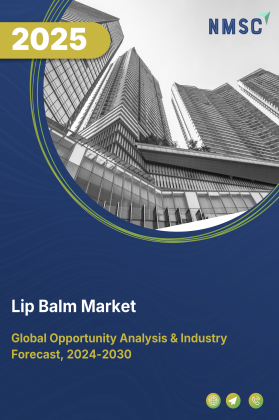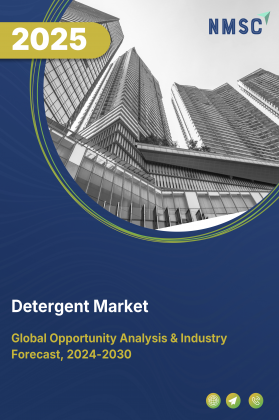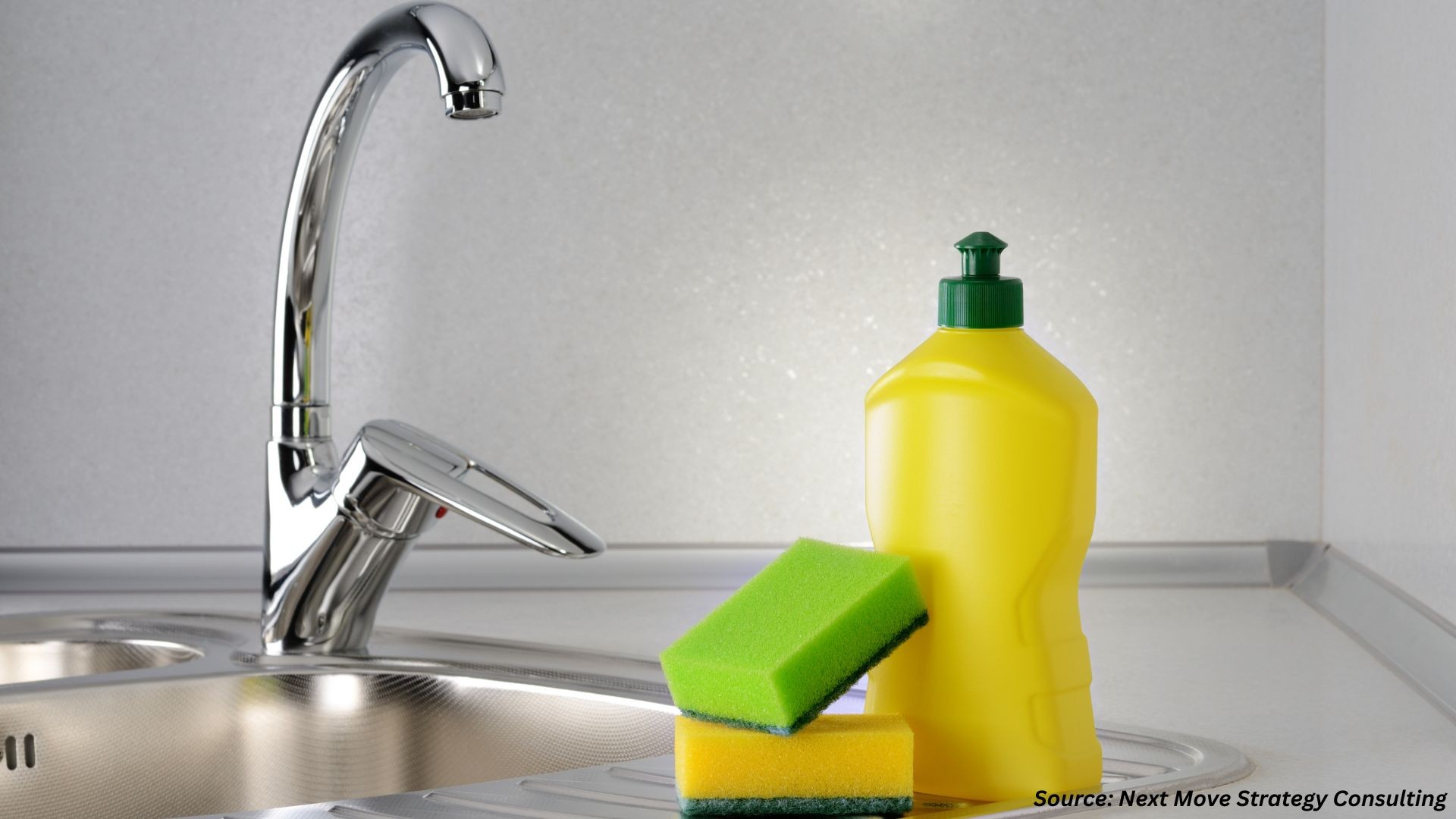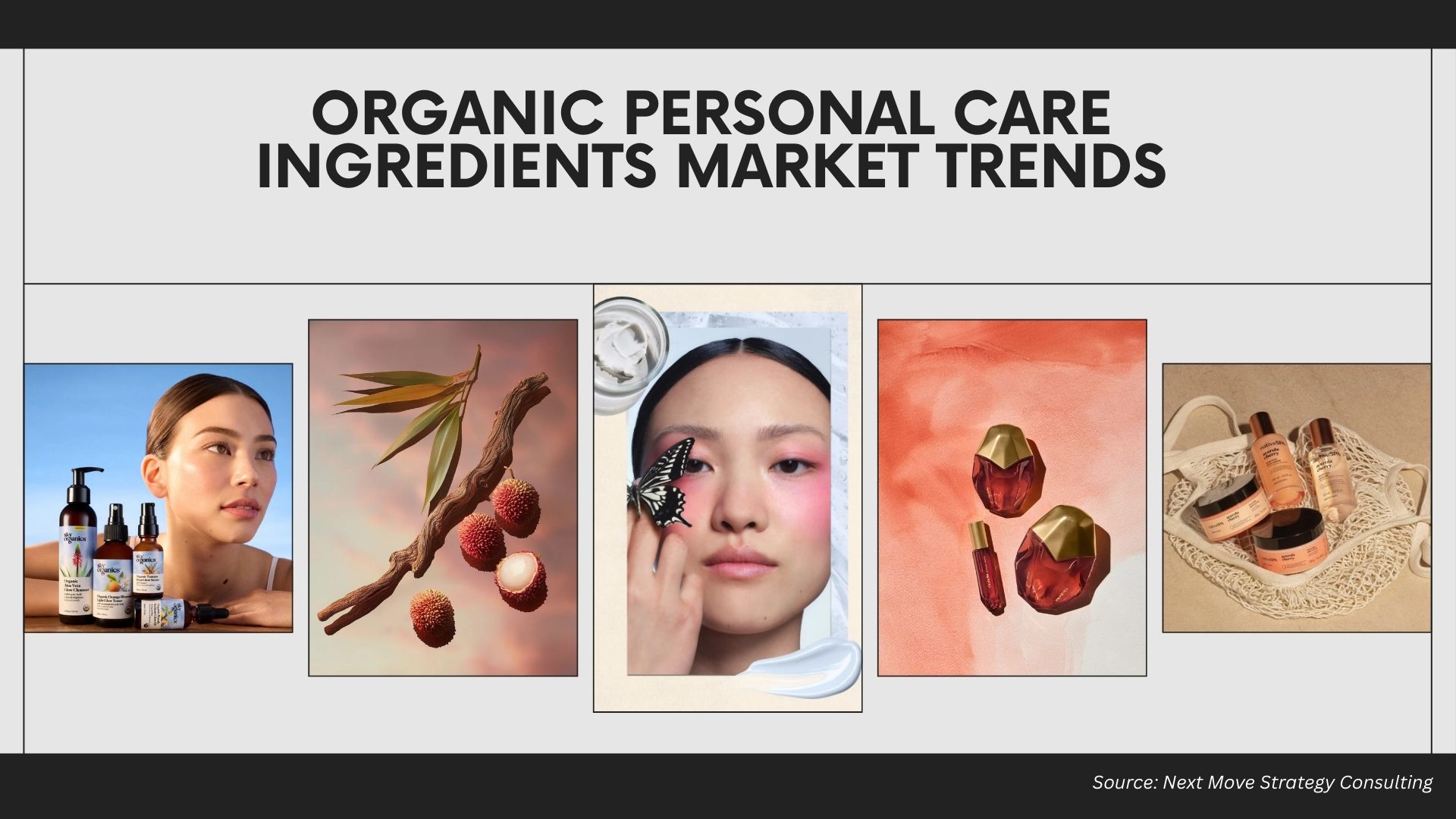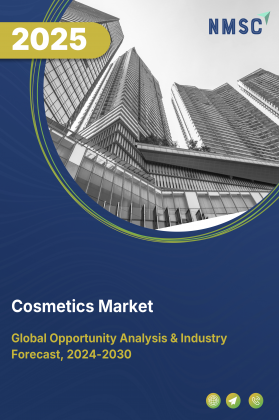
Cosmetics Market by Product Type (Skin Care, Hair Care, Makeup, Fragrances, Personal Hygiene, Natural and Organic Products, Cosmetic Tools and Accessories), by Price Segment (Mass Market, Premium, Luxury), by Distribution Channel (Specialty Stores, Department Stores, Online Retail, Supermarkets and Hypermarkets, Pharmacies and Drugstores), by End User (Women, Men, Children) – Global Analysis & Forecast, 2025–2030
Industry Outlook
The global Cosmetics Market size was valued at USD 487.28 billion in 2024, and is expected to be valued at USD 516.51 billion by the end of 2025. The industry is projected to grow, hitting USD 691.21 billion by 2030, with a CAGR of 6.0% between 2025 and 2030.
The cosmetics market is undergoing rapid transformation, driven by rising urbanization, evolving consumer lifestyles, and increasing demand for functional, aesthetic, and sustainable beauty solutions. Globally, the surge in beauty-conscious consumers, growing awareness of personal care, and rising disposable incomes are fuelling demand for innovative and multifunctional cosmetic products. Expanding retail networks, e-commerce penetration, and beauty trends amplified by lifestyle influencers and digital platforms are reshaping consumer preferences. Advancements in natural and eco-friendly ingredients, innovative formulations, and personalized beauty solutions are driving product innovation. Furthermore, sustainable sourcing practices, customizable cosmetic offerings, and visually appealing packaging are enhancing user experience, fostering brand loyalty, and redefining modern beauty routines.
What are the Key Cosmetics Market Trends?
What are the Major Technological Trends Shaping the Market?
Technological advancements are transforming the cosmetics landscape. AI and AR-enabled tools are enhancing personalized skincare and makeup experiences, allowing virtual try-ons and customized recommendations. Automation and robotics in manufacturing ensure product consistency, precision, and large-scale customization. Innovations in formulations, such as non-toxic, vegan, and cruelty-free ingredients, as well as smart packaging with QR codes and product tracking, are improving user engagement and product efficacy. Sustainable manufacturing technologies, including energy-efficient processes, biodegradable packaging, and recyclable materials, are increasingly being adopted to meet eco-conscious consumer demands.
How Is Demographic Change Influencing the Market?
Demographic and societal shifts are significantly shaping the market. Younger consumers are driving demand for multifunctional, tech-integrated, and eco-friendly beauty solutions, while aging populations in developed regions are seeking anti-aging, dermatologically tested, and easy-to-apply products. Rising urbanization and increasing disposable incomes are boosting premium and luxury cosmetic consumption. Cultural diversity and the growth of inclusive beauty awareness are prompting brands to offer a wider range of shades, formulations, and targeted solutions for varied skin types and preferences.
What Role Does Government Support Play in Driving Cosmetics Market Growth?
Government initiatives are supporting growth in the cosmetics industry through incentives for domestic manufacturing, export promotion, and MSME development. Regulations on product safety, ingredient transparency, and labeling standards enhance consumer trust. Environmental policies and sustainability mandates encourage manufacturers to adopt green formulations, recyclable packaging, and carbon-efficient production methods. Additionally, programs supporting women entrepreneurs and small-scale beauty startups are fostering innovation and market diversity.
How is Consumer Preference Changing in the Market?
Consumer behavior is shifting toward personalized, sustainable, and design-led cosmetic solutions. There is growing preference for clean, cruelty-free, and natural ingredients alongside product efficacy. Digital beauty experiences, such as AI-based skincare diagnostics and AR try-ons, are gaining traction. Ethical sourcing, eco-friendly packaging, and brand transparency are key purchase drivers. Overall, consumers increasingly view cosmetics as tools for self-expression, lifestyle alignment, and conscious consumption, driving brands to innovate in formulation, marketing, and delivery.
What are the Key Market Drivers, Breakthroughs, and Investment Opportunities that Will Shape the Cosmetics Industry in Next Decade?
The market is witnessing robust growth driven by rapid urbanization, rising disposable incomes, and evolving beauty and lifestyle preferences. Increasing demand for personalized, multifunctional, and aesthetically appealing beauty products is fueling adoption across diverse consumer segments. The rapid expansion of e-commerce platforms and modern retail channels is enhancing product accessibility, promoting premium and niche offerings, and enabling emerging brands to compete effectively. However, high raw material and production costs, along with stringent regulatory standards, pose challenges that impact pricing and profit margins. Meanwhile, the growing popularity of clean beauty, sustainable formulations, and tech-driven innovations, such as AI-powered skincare and AR-based virtual try-ons, presents significant opportunities for brands to offer eco-friendly, customized, and technology-integrated cosmetic solutions that resonate with modern, health-conscious, and socially aware consumers.
The bar chart illustrates household disposable income in USD PPP for selected countries in 2024–2025. Among the countries shown, Japan has the highest per capita disposable income at USD 67,468, followed by Germany at USD 52,296, the United Kingdom at USD 47,670, Canada at USD 47,260, and South Korea at USD 39,965. Higher disposable income in these countries directly correlates with increased spending capacity on Cosmetics products, particularly premium, multifunctional, and design-focused items. Consumers in Japan and Germany are more likely to invest in high-quality skincare, hair care, makeup, fragrances, and personal hygiene products, driving demand for both innovative and branded offerings. In contrast, countries with relatively lower disposable income prioritize affordable and essential Cosmetics products, influencing product mix, price sensitivity, and marketing strategies in the global market.
Growth Drivers:
How is Rising Disposable Incomes Driving the Cosmetics Market Demand?
Increasing disposable income levels, particularly in emerging economies, are a major driver of the cosmetics market. As consumers gain greater purchasing power, they are more willing to spend on premium, luxury, and specialized beauty products. Higher income levels also enable consumers to experiment with new brands, invest in skincare routines, and adopt diverse cosmetic categories such as organic, anti-aging, and personalized solutions. This trend is especially evident among urban and middle-class populations, where beauty and personal grooming are increasingly associated with social status, self-expression, and lifestyle enhancement. Consequently, rising disposable income continues to expand the consumer base and fuel overall market growth.
The chart illustrates the urban population in million across selected countries in 2024. Germany has the largest urban population at 65.05 million, followed by the United Kingdom at 58.76 million, France at 56.21 million, South Korea at 42.17 million, Canada at 33.84 million, and Australia at 23.60 million. Larger urban populations typically drive higher demand for Cosmetics products, as city dwellers generally have greater purchasing power, better access to modern retail and e-commerce channels, and a preference for space-efficient, multifunctional, and premium personal care items. Countries such as Germany, the United Kingdom, and France are therefore expected to contribute significantly to global market growth, while markets with smaller urban populations tend to focus more on affordable and essential products, influencing product offerings and pricing strategies
Is Expansion of E-Commerce and Modern Retail Channels Accelerating the Market Growth?
The rapid expansion of e-commerce platforms and modern retail formats is significantly driving the growth of the cosmetics market. Online channels offer consumers greater accessibility, convenience, and product variety, enabling them to compare prices, read reviews, and discover global brands from anywhere. The rise of social media marketing, influencer collaborations, and virtual try-on technologies has further enhanced online engagement and purchasing confidence. Simultaneously, modern retail outlets such as specialty beauty stores, multi-brand chains, and experiential showrooms are improving product visibility and consumer experience. This omnichannel retail growth is bridging the gap between digital and physical shopping, expanding market reach, and boosting overall cosmetic sales worldwide.
The pie chart depicts the global e-commerce market share by country in 2025, with China leading at 52.1%, followed by the USA at 20.1%. The United Kingdom and Japan contribute 3.4% and 3.3%, while South Korea, Germany, and France hold 2.5%, 1.7%, and 1.4%, respectively. The remaining countries collectively account for 15.5% under “Other.” The dominance of e-commerce in countries like China and the USA presents a significant opportunity for Cosmetics companies to reach consumers through online channels. Digital retail enables convenient access to skincare, hair care, makeup, fragrances, and personal hygiene products, particularly for urban and tech-savvy consumers. Markets with smaller e-commerce penetration still rely heavily on physical retail, but global trends indicate that growing online adoption will increasingly shape Cosmetics distribution strategies worldwide.
Growth Inhibitors:
How Does Stringent Regulatory Standards and Compliance Requirements Limit the Growth of the Market?
One of the major restraints of the market is the presence of stringent regulatory standards governing product safety, labeling, and ingredient usage. Regulatory authorities across regions impose strict guidelines to ensure consumer health and environmental safety, requiring extensive testing, certification, and documentation before product launches. Compliance with these varying international standards increases production costs and delays market entry, particularly for smaller and emerging brands. Additionally, frequent changes in regulations related to chemical ingredients, animal testing bans, and sustainability requirements disrupt supply chains and limit innovation, thereby constraining overall market growth.
How is Growing Demand for Natural and Sustainable Cosmetics Creating Opportunity for the Market?
A major opportunity in the market lies in the rising global demand for natural, organic, and sustainable beauty products. Consumers are increasingly prioritizing health-conscious and eco-friendly choices, driving brands to develop formulations using plant-based, cruelty-free, and non-toxic ingredients. This shift is creating strong growth prospects for companies that invest in green chemistry, biodegradable packaging, and transparent sourcing practices. As sustainability becomes a key differentiator, brands that align with ethical and environmental values build stronger consumer loyalty, attract premium segments, and expand their presence in both developed and emerging markets.
How Cosmetics Market is Segmented in this Report, and What are the Key Insights from the Segmentation Analysis?
By Product Type Insights
Which Product Type Is Expected to Drive the Market in 2025?
On the basis of product type, the market is segmented into Skin Care, Hair Care, Makeup, Fragrances, Personal Hygiene, Natural and Organic Products, and Cosmetic Tools and Accessories. The market in 2025 is expected to be primarily driven by Skin Care. Skin Care continues to dominate consumer preference due to its essential role in daily personal care, growing awareness of health and wellness, and the increasing demand for products that cater to anti-aging, sensitive skin, and multifunctional care. It also appeals to consumers seeking premium formulations, convenience, and scientifically backed products, with rising interest in natural, organic, and dermatologically tested offerings further boosting its market share.
While other segments such as hair care, makeup, fragrances, personal hygiene, natural and organic products, and cosmetic tools and accessories are gaining traction owing to self-expression, grooming trends, and lifestyle-driven preferences, skin care remains the backbone of the cosmetics market. Additionally, the Natural and Organic Products segment is emerging as a high-potential category, driven by rising consumer interest in eco-friendly, cruelty-free, and sustainable formulations that cater to conscious living and premium personal care habits.
By Price Segment Insights
Which Consumer Spending Tier is Poised to Shape the Cosmetics Market in 2025?
On the basis of price segment, the market is segmented into mass market, premium, and luxury. The market in 2025 is expected to be primarily driven by the Premium segment. Premium products continue to capture consumer attention due to their perceived quality, advanced formulations, and aspirational appeal. Consumers are increasingly seeking products that deliver efficacy, safety, and brand trust, with growing demand for specialized skincare, hair care, and makeup solutions further strengthening the segment’s market share.
While the Mass Market segment remains important due to affordability and wide accessibility, and the Luxury segment targets niche consumers looking for exclusivity and high-end experiences, Premium remains the central growth driver of the cosmetics market. Additionally, the Luxury segment is emerging as a high-potential category, fueled by demand for exclusive, celebrity-endorsed, and sustainable formulations that appeal to affluent and trend-conscious consumers.
By Distribution Channel Insights
Which Sales Channel is Set to Drive Growth in the Cosmetics Market in 2025?
On the basis of distribution channel, the market is segmented into Specialty Stores, Department Stores, Online Retail, Supermarkets and Hypermarkets, and Pharmacies and Drugstores. The market in 2025 is expected to be primarily driven by Online Retail. Online channels continue to gain prominence due to convenience, a wide product assortment, competitive pricing, and easy access to global brands. The increasing adoption of e-commerce platforms, mobile shopping apps, and social commerce further boosts consumer engagement and sales.
While Specialty Stores and Department Stores remain important for brand experience and premium product purchases, and Supermarkets, Hypermarkets, and Pharmacies offer convenience and accessibility, Online Retail is emerging as the central growth engine of the cosmetics market. Additionally, emerging omnichannel strategies combining online and offline experiences are enhancing consumer satisfaction and driving loyalty across all distribution channels.
By End User Insights
Which Consumer Group Will Lead Demand in the Cosmetics Market in 2025?
On the basis of end user, the market is segmented into Women, Men, and Children. The market in 2025 is expected to be primarily driven by Women. Female consumers continue to dominate demand due to higher engagement with skincare, makeup, and personal care routines, as well as a growing focus on wellness, beauty, and self-expression. The rising influence of social media, beauty influencers, and personalized recommendations further strengthens their purchasing behavior.
While the Men segment is experiencing steady growth driven by grooming trends and increasing awareness of skincare and hair care, and the Children segment remains niche with specialized products, Women remain the backbone of the cosmetics market. Additionally, the Men segment is emerging as a high-potential category, fueled by lifestyle changes, premium grooming products, and increased acceptance of male beauty routines.
Regional Outlook
The market is geographically studied across North America, Europe, Asia Pacific, and the Middle East & Africa, and each region is further studied across countries.
Cosmetics Market in North America
The North American market is being driven by urbanization, rising disposable incomes, and evolving consumer lifestyles. Increasing demand for multifunctional, personalized, and aesthetically appealing cosmetic products is fueling growth, while expanding retail networks, including specialty stores, supermarkets, and e-commerce platforms, are enhancing product accessibility and visibility. Consumers are increasingly seeking premium, sustainable, and technologically advanced beauty solutions, creating opportunities for innovative formulations, smart skincare tools, and eco-friendly packaging.
Cosmetics Market in the United States
In the U.S. market growth is primarily fueled by the adoption of premium, tech-enabled, and multifunctional cosmetic products. Design-conscious and digitally savvy consumers are seeking solutions that combine efficacy, convenience, and personalization. Expansion of organized retail, online channels, and direct-to-consumer platforms allows brands to reach diverse consumer segments effectively. Innovation in AI-driven skincare, virtual try-on tools, and sustainable formulations is enabling differentiation and fostering brand loyalty.
Cosmetics Market in Canada
In Canada, demand is driven by urbanization, rising disposable incomes, and growing preference for eco-friendly and natural cosmetic products. Consumers favor multifunctional, space-efficient, and high-quality formulations, while modern retail formats and e-commerce platforms expand product reach and accessibility. Rising awareness of sustainability encourages manufacturers to innovate in clean, cruelty-free ingredients, recyclable packaging, and energy-efficient production methods, aligning with environmentally conscious and lifestyle-oriented consumer preferences.
Cosmetics Market in Europe
The European market benefits from a strong focus on sustainability, innovation, and product efficacy. Consumers are adopting premium, multifunctional, and eco-friendly cosmetic products with natural and safe formulations. Growth is supported by retail modernization, expanding e-commerce channels, and increasing awareness of environmental impact and ingredient transparency. Innovation in personalized beauty solutions, smart skincare devices, and sustainable packaging provides opportunities for brands to cater to varied consumer preferences across the region.
Cosmetics Market in the United Kingdom
In the U.K. market growth is driven by urbanization, rising disposable incomes, and increasing demand for premium, multifunctional, and smart cosmetic solutions. Consumers prioritize product efficacy, aesthetics, and convenience, while e-commerce and modern retail channels improve accessibility and choice. Sustainability trends, including natural ingredients, recyclable packaging, and energy-efficient production, are shaping purchasing decisions. Government initiatives promoting sustainability and ethical manufacturing further encourage adoption of innovative cosmetic products, sustaining steady market growth.
Cosmetics Market in Germany
Germany’s market is primarily driven by consumers’ preference for premium, multifunctional, and eco-friendly cosmetic products. Urban populations with higher disposable incomes are increasingly investing in innovative skincare, makeup, and grooming solutions that combine efficacy, design, and convenience. The market benefits from the expansion of modern retail outlets, specialty stores, and e-commerce platforms, making products more accessible across urban and semi-urban regions. Sustainability remains a key consideration, with consumers favoring natural ingredients, recyclable packaging, and energy-efficient production, encouraging manufacturers to offer differentiated and environmentally responsible solutions.
Cosmetics Market in France
In France, market growth is supported by urbanization, rising disposable incomes, and a strong focus on health, wellness, and sustainable living. Consumers are increasingly seeking premium, multifunctional, and environmentally conscious cosmetic products that align with modern lifestyles and eco-friendly values. Retail modernization, including specialty stores, lifestyle outlets, and e-commerce platforms, is enhancing product visibility and convenience, allowing consumers to explore diverse beauty options. There is also growing demand for innovative, ergonomic, and personalized products, creating opportunities for brands to differentiate through design, functionality, and sustainability, catering to consumers who prioritize quality, aesthetics, and long-term value.
Cosmetics Market in Spain
Spain’s market is witnessing strong growth, driven by rising urban populations, increasing disposable incomes, and expanding access to modern retail and online shopping platforms. Urban consumers are showing preference for premium, multifunctional, and personalized cosmetics. Sustainability trends and eco-conscious purchasing behavior are encouraging manufacturers to adopt natural ingredients, chemical-free formulations, and recyclable packaging. Additionally, consumers increasingly value products that combine convenience, durability, and aesthetic appeal, creating opportunities for brands to innovate in personalized offerings, smart beauty tools, and lifestyle-oriented solutions.
Cosmetics Market in Italy
The Italian market is fueled by growing awareness of health and wellness, urbanization, and rising disposable incomes. Consumers are increasingly seeking premium, multifunctional, and sustainable cosmetic products that enhance personal care routines, convenience, and aesthetics. Modern retail chains, specialty stores, and e-commerce platforms are expanding product accessibility and offering opportunities for impulse purchases and customized solutions. There is a growing trend toward eco-friendly formulations, energy-efficient production, and technology-enabled beauty solutions, allowing brands to differentiate through innovation, design, and sustainability, thereby driving market growth and loyalty.
Cosmetics Market in the Nordics
In the Nordic countries, the market is driven by high consumer awareness of wellness, sustainability, and product quality. Urban households with higher disposable incomes are seeking premium, multifunctional, and eco-friendly cosmetic products, including smart skincare devices and personalized formulations. Strong trends toward environmental responsibility and sustainable lifestyles encourage manufacturers to innovate in natural ingredients, production methods, and product designs. Modern retail outlets and e-commerce platforms provide enhanced accessibility and convenience, allowing consumers to explore a wide range of offerings. The combination of functionality, sustainability, and aesthetics supports steady market growth in the region.
Cosmetics Market in Asia Pacific
The Asia Pacific market is expanding rapidly, driven by urbanization, rising disposable incomes, and growing health and lifestyle awareness. Countries such as India, China, South Korea, and Australia are witnessing strong demand for premium, multifunctional, and eco-friendly cosmetic products. Consumers are increasingly seeking personalized, convenient, and aesthetically appealing solutions. Expansion of modern retail chains, specialty stores, and e-commerce platforms is improving product visibility and reach. Additionally, rising awareness of sustainability and clean beauty is encouraging manufacturers to innovate with natural ingredients, reusable packaging, and smart beauty technologies, creating substantial opportunities for growth and differentiation.
Cosmetics Market in China
China’s market growth is fueled by rapid urbanization, rising disposable incomes, and increasing demand for premium, multifunctional, and eco-friendly cosmetic products. Urban consumers are seeking durable, personalized, and aesthetically appealing solutions, including skincare, makeup, and grooming tools. The proliferation of e-commerce platforms and modern retail chains enhances product accessibility across both urban and semi-urban regions. Growing awareness of sustainability, clean formulations, and environmentally responsible manufacturing is encouraging innovation in ingredients, design, and technology integration. This combination of rising consumer expectations and technological advancements is driving steady market expansion and creating opportunities for both domestic and international brands.
Cosmetics Market in Japan
Japan’s market is shaped by an aging population, high health consciousness, and the premiumization of personal care products. Consumers increasingly seek gentle, multifunctional, and ergonomically designed cosmetics that cater to convenience, wellness, and comfort. Demand for durable, space-efficient, and aesthetically appealing products is particularly strong among urban households. Accessibility is supported by modern retail chains, specialty stores, and online platforms. Sustainability trends and eco-friendly formulations are driving innovation in natural, energy-efficient, and environmentally responsible cosmetics, enhancing product differentiation and brand loyalty.
Cosmetics Market in India
India’s market is witnessing significant growth, driven by rapid urbanization, rising disposable incomes, and increasing awareness of modern beauty solutions. Consumers are seeking premium, multifunctional, and space-efficient cosmetic products. The expansion of e-commerce platforms and organized retail enhances accessibility and variety. Growing health consciousness, evolving lifestyles, and sustainability focus are encouraging innovation in formulations, packaging, and personalized solutions, creating substantial opportunities for both domestic and international brands.
Cosmetics Market in South Korea
In South Korea, market growth is driven by urbanization, rising disposable incomes, and growing consumer focus on convenience, wellness, and sustainability. Urban households increasingly demand premium, multifunctional, and eco-friendly cosmetics. Availability through modern retail and e-commerce platforms ensures broad access, while consumers’ preference for durable, energy-efficient, and stylish products drives innovation. Manufacturers are responding with technology-integrated solutions, eco-conscious ingredients, and customizable formulations, supporting consistent market expansion.
Cosmetics Market in Taiwan
Taiwan’s market is fueled by health-conscious and lifestyle-oriented consumers, urbanization, and rising disposable incomes. Demand is strong for premium, multifunctional, and sustainable cosmetic products. Exposure to global trends encourages adoption of eco-friendly, safe, and durable formulations. Modern retail chains and online platforms enhance accessibility, while sustainability and environmentally responsible product design create opportunities for differentiation and innovation.
Cosmetics Market in Indonesia
Indonesia’s market is driven by rapid urbanization, an expanding middle-class population, and increasing awareness of modern beauty solutions. Consumers demand premium, multifunctional, and space-efficient cosmetic products, while e-commerce and modern retail improve accessibility and variety. Rising interest in eco-friendly, durable, and chemical-free formulations encourages innovation in design, ingredients, and functionality, creating strong growth potential across urban and semi-urban regions.
Cosmetics Market in Australia
Australia’s market is driven by urbanization, rising disposable incomes, and growing preference for premium and multifunctional products. Urban consumers seek eco-friendly, durable, and design-oriented cosmetics that combine functionality with aesthetics. Expansion of modern retail, specialty stores, and online platforms enhances accessibility and visibility. Sustainability trends and environmentally conscious behavior are encouraging manufacturers to innovate with biodegradable, chemical-free, and energy-efficient products, supporting growth and brand differentiation.
Cosmetics Market in Latin America
In Latin America, market growth is fueled by rapid urbanization, increasing disposable incomes, and rising awareness of modern beauty solutions and wellness. Countries such as Brazil, Mexico, and Argentina are witnessing strong demand for premium, multifunctional, and space-efficient cosmetic products. Expansion of organized retail and e-commerce platforms improves accessibility and variety, while consumer interest in eco-friendly, durable, and aesthetically appealing products drives innovation. Urban and semi-urban populations are particularly adopting products that combine functionality, style, and sustainability, creating significant opportunities for both local and international brands.
Cosmetics Market in the Middle East & Africa
The Middle East and Africa market is supported by urbanization, rising disposable incomes, and growing consumer focus on wellness and modern beauty solutions. Consumers are seeking premium, multifunctional, and durable cosmetics that combine convenience, style, and environmental responsibility. Expansion of retail chains, specialty stores, and e-commerce platforms enhances accessibility and visibility across urban centers. Sustainability trends, eco-friendly formulations, and energy-efficient production are encouraging innovation, enabling manufacturers to differentiate offerings and drive steady market growth across the region.
Competitive Landscape
Which Companies Dominate the Cosmetics Market and How do they Compete?
The global market is dominated by multinational giants such as L’Oréal, Estée Lauder, Shiseido, Coty, Revlon, Chanel, and Kao, alongside specialized and niche players including Barry M, Radical Cosmetics, Mary Kay, Oriflame, Polliam, Intercos, Clarins, and FANCL. These companies compete by offering a wide range of skincare, haircare, makeup, fragrance, and multifunctional beauty products, catering to mass-market, premium, eco-conscious, and niche segments. Market leaders differentiate themselves through innovation, premium formulations, multifunctional products, sustainable ingredients, and advanced packaging, while investing in strong branding, marketing campaigns, and extensive distribution networks both online and offline. Niche and regional players focus on personalized, artisanal, eco-friendly, or wellness-oriented products that meet local consumer preferences. Companies that successfully combine innovation, sustainability, operational efficiency, and modern design trends capture market share, strengthen consumer loyalty, and maintain a competitive edge in the increasingly dynamic global cosmetics landscape.
Market dominated by Cosmetics Market Giants and Specialists
The market exhibits a dual structure, where large multinational corporations coexist with regional and niche players. Major companies capitalize on strong brand recognition, extensive distribution channels, and diverse product portfolios to provide a full spectrum of cosmetic solutions, ranging from mass-market to premium and specialized products. In contrast, smaller or niche brands concentrate on organic, eco-friendly, or customized offerings that cater to local consumer preferences, wellness trends, or high-end segments. This duality gives consumers the option to rely on established brands for consistency and variety or choose specialized brands that offer unique features, sustainability, and personalized solutions.
Innovation and Adaptability Drive Market Success
Innovation and adaptability are key drivers of success in the market. Leading companies invest in cutting-edge production technologies, sustainable raw materials, and eco-conscious packaging while developing multifunctional, ergonomic, and design-focused products. Market trends such as personalization, wellness-centric products, and natural or chemical-free formulations shape product development strategies. Continuous innovation in aesthetics, functionality, durability, and sustainability enables brands to differentiate themselves, strengthen market presence, and foster consumer loyalty. Companies that quickly adapt to lifestyle and sustainability trends retain a competitive advantage in a crowded and evolving market.
Market Players to Opt for Merger & Acquisition Strategies to Expand Their Presence
Mergers and acquisitions (M&A) have emerged as a key strategy for market players aiming to broaden product lines, enter new geographic regions, and acquire specialized expertise. Leading manufacturers acquire regional or niche brands to enhance market share, diversify offerings, and integrate advanced production technologies. These M&A activities enable companies to access emerging consumer segments, scale operations efficiently, and meet growing demand for premium, multifunctional, and eco-friendly cosmetics. By consolidating capabilities and expanding market presence, companies improve competitive positioning across both mass-market and specialized categories while effectively responding to evolving consumer needs.
List of Key Cosmetics Companies
-
L’Oréal S.A.
-
The Estée Lauder Companies Inc.
-
Coty Inc.
-
Revlon, Inc.
-
Barry M Cosmetics
-
RADICAL COSMETICS
-
Mary Kay Inc.
-
Kao Corporation
-
Oriflame Holding AG
-
Polliam Cosmetics
-
INTERCOS S.P.A
-
Chanel S.A.
-
Clarins Group
-
FANCL Corporation
What are the Latest Key Industry Developments?
-
October 2025 - Estée Lauder hosted a launch event in New York City to celebrate the opening of four new fragrance stores under its brand portfolio, including Kilian Paris, Jo Malone London, Editions de Parfums Frédéric Malle, and Tom Ford Beauty.
-
August 2025 - Shiseido announced plans to cut 300 jobs in the U.S. as part of a restructuring effort. The company aims to reposition the Drunk Elephant brand by 2026 and expects USD 102 million in U.S. cost savings by that year.
-
June 2025 - Mary Kay was named the #1 direct selling brand of skin care and color cosmetics in the world for three consecutive years, according to Euromonitor International. The company also ranked #11 in Women's Wear Daily Beauty Inc.'s 2024 Top 100 Beauty Companies.
-
February 2025 - L’Oréal achieved USD 50.5 billion in sales, marking a 5.6% increase. The company reported a record operating margin of 20%, driven by growth across all divisions and regions, except North Asia.
-
September 2024 - Barry M launched its 'That's Swell' Peptide Plumping Lip Oils for Autumn 2024. The product aims to provide a blend of hydration and volume.
What are the Key Factors Influencing Investment Analysis & Opportunities in the Cosmetics Market?
The market is drawing increasing investor interest as global demand grows for premium, multifunctional, and design-oriented personal care and beauty products. Companies offering innovative, sustainable, eco-friendly, and technologically advanced cosmetics are particularly attractive, with investments focused on scalable production, research and development, and product innovation. Market activity is especially strong in North America, Europe, and Asia-Pacific, driven by urbanization, rising disposable incomes, changing lifestyles, and heightened consumer focus on wellness, convenience, and sustainability. Strategic mergers, acquisitions, and partnerships by leading manufacturers indicate market consolidation as a significant growth strategy. For investors, the most promising opportunities lie in companies that combine diverse product portfolios, technological and design innovation, operational efficiency, and the ability to adapt to evolving consumer preferences across mass-market, premium, and niche segments. Brands that successfully align with sustainability trends, personalization, and multifunctional product demands are positioned to deliver high returns and long-term growth in the cosmetics sector.
Key Benefits for Stakeholders:
Next Move Strategy Consulting (NMSC) presents a comprehensive analysis of the cosmetics market, covering historical trends from 2020 through 2024 and offering detailed forecasts through 2030. Our study examines the market at global, regional, and country levels, providing quantitative projections and insights into key growth drivers, challenges, and investment opportunities across all major market segments.
Report Scope:
|
Parameters |
Details |
|
Market Size in 2025 |
USD 516.51 Billion |
|
Revenue Forecast in 2030 |
USD 691.21 Billion |
|
Growth Rate |
CAGR of 6.0% from 2025 to 2030 |
|
Analysis Period |
2024–2030 |
|
Base Year Considered |
2024 |
|
Forecast Period |
2025–2030 |
|
Market Size Estimation |
Billion (USD) |
|
Growth Factors |
|
|
Companies Profiled |
15 |
|
Countries Covered |
28 |
|
Market Share |
Available for 10 companies |
|
Customization Scope |
Free customization (equivalent to up to 80 analyst-working hours) after purchase. Addition or alteration to country, regional & segment scope. |
|
Pricing and Purchase Options |
Avail customized purchase options to meet your exact research needs. |
|
Approach |
In-depth primary and secondary research; proprietary databases; rigorous quality control and validation measures. |
|
Analytical Tools |
Porter's Five Forces, SWOT, value chain, and Harvey ball analysis to assess competitive intensity, stakeholder roles, and relative impact of key factors. |
Key Market Segments
By Product Type
-
Skin Care
-
Facial Care
-
Moisturizers
-
Cleansers
-
Toners
-
Serums
-
Masks
-
Eye Care
-
-
Body Care
-
Lotions
-
Oils
-
Body Wash
-
Hand and Foot Care
-
-
Specialized Products
-
Anti-Aging
-
Whitening and Brightening
-
Acne Treatment
-
Sensitive Skin Care
-
-
-
Hair Care
-
Shampoo
-
Conditioner
-
Hair Styling Products
-
Hair Color
-
Hair Treatments
-
Hair Oils
-
-
Makeup
-
Face Makeup
-
Foundation
-
Concealer
-
Powder
-
Blush
-
Highlighter
-
-
Eye Makeup
-
Eyeliner
-
Mascara
-
Eyeshadow
-
Eyebrow Products
-
-
Lip Makeup
-
Lipstick
-
Lip Gloss
-
Lip Liner
-
-
Nail Products
-
Nail Polish
-
Nail Care
-
-
-
Fragrances
-
Perfumes
-
Body Sprays
-
Deodorants
-
-
Personal Hygiene
-
Oral Care
-
Toothpaste
-
Mouthwash
-
-
Bath and Shower Products
-
Soaps
-
Shower Gels
-
Body Scrubs
-
-
-
Natural and Organic Products
-
Skin Care
-
Hair Care
-
Makeup
-
Personal Hygiene
-
-
Cosmetic Tools and Accessories
-
Brushes and Applicators
-
Sponges
-
Cosmetic Bags
-
Beauty Devices
-
By Price Segment
-
Mass Market
-
Premium
-
Luxury
By Distribution Channel
-
Specialty Stores
-
Department Stores
-
Online Retail
-
Supermarkets and Hypermarkets
-
Pharmacies and Drugstores
By End User
-
Women
-
Men
-
-
Children
Geographical Breakdown
-
North America: U.S., Canada, and Mexico.
-
Europe: U.K., Germany, France, Italy, Spain, Sweden, Denmark, Finland, Netherlands, and rest of Europe.
-
Asia Pacific: China, India, Japan, South Korea, Taiwan, Indonesia, Vietnam, Australia, Philippines, Malaysia and rest of APAC.
-
Middle East & Africa (MEA): Saudi Arabia, UAE, Egypt, Israel, Turkey, Nigeria, South Africa, and rest of MEA.
-
Latin America: Brazil, Argentina, Chile, Colombia, and rest of LATAM
Conclusion & Recommendations
Our report equips stakeholders, industry participants, investors, policy-makers, and consultants with actionable intelligence to capitalize on market’s transformative potential. By combining robust data-driven analysis with strategic frameworks, NMSC’s cosmetics market report serves as an indispensable resource for navigating the evolving landscape.




















 Speak to Our Analyst
Speak to Our Analyst




